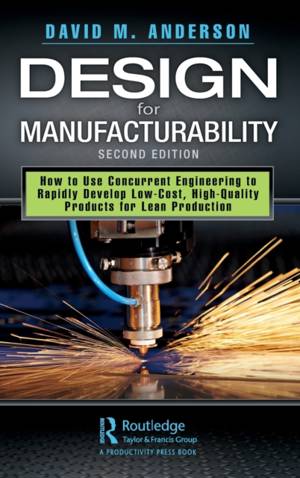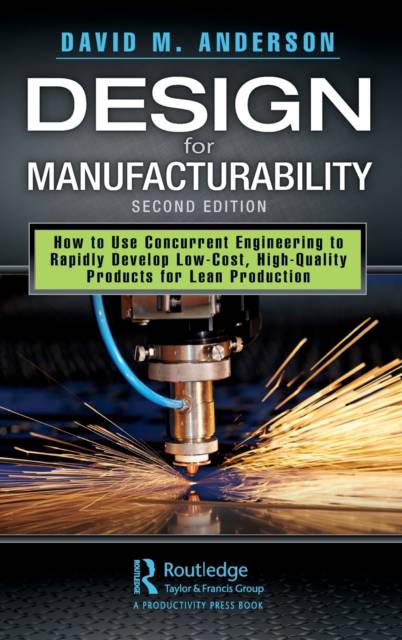
- Afhalen na 1 uur in een winkel met voorraad
- Gratis thuislevering in België vanaf € 30
- Ruim aanbod met 7 miljoen producten
- Afhalen na 1 uur in een winkel met voorraad
- Gratis thuislevering in België vanaf € 30
- Ruim aanbod met 7 miljoen producten
Design for Manufacturability
How to Use Concurrent Engineering to Rapidly Develop Low-Cost, High-Quality Products for Lean Production, Second Edition
David M AndersonOmschrijving
Achieve any cost goals in half the time and achieve stable production with quality designed in right-the-first-time.
Design for Manufacturability: How to Use Concurrent Engineering to Rapidly Develop Low-Cost, High-Quality Products for Lean Production is still the definitive work on DFM. This second edition extends the proven methodology to the most advanced product development process with the addition of the following new, unique, and original topics, which have never been addressed previously. These topics show you how to:
- Cut cost from 1/2 to 1/10 in 9 categories--with ways to remove that much cost from product charges and pricing
- Commercialize innovation--starting with Manufacturable Research and learning from the new section on scalability, you will learn how to design products and processing equipment to quickly scale up to any needed demand or desired growth. Design product families that can be built "on-demand" in platform cells that also "mass customize" products to-order
- Make Lean production easier to implement with much more effective results while making build-to-order practical with spontaneous supply chains and eliminating forecasted inventory by including an updated chapter on "Designing Products for Lean Production"
The author's 30 years of experience teaching companies DFM based on pre-class surveys and plant tours is the foundation of this most advanced design process. It includes incorporating dozens of proven DFM guidelines through up-front concurrent-engineering teamwork that cuts the time to stable production in half and curtails change orders for ramps, rework, redesign, substituting cheaper parts, change orders to fix the changes, unstable design specs, part obsolescence, and late discovery of manufacturability issues at periodic design reviews. This second edition is for the whole product development community, including:
- Engineers who want to learn the most advanced DFM techniques
- Managers who want to lead the most advanced product development
- Project team leaders who want to immediately apply all the principles taught in this book in their own micro-climate
- Improvement leaders and champions who want to implement the above and ensure that the company can design products and versatile processing equipment for low-volume/high-mix product varieties
Designing half to a tenth of cost categories can avoid substituting cheap parts, which degrades quality, and encourages standardization and spontaneous supply chains, which will encourage Lean initiatives. Using cellular manufacturing to shift production between lines for mixed production of platforms and build-to-order to offer the fastest order fulfillment can beat any competitors' delivery time.
Specificaties
Betrokkenen
- Auteur(s):
- Uitgeverij:
Inhoud
- Aantal bladzijden:
- 590
- Taal:
- Engels
Eigenschappen
- Productcode (EAN):
- 9780367249946
- Verschijningsdatum:
- 27/05/2020
- Uitvoering:
- Hardcover
- Formaat:
- Genaaid
- Afmetingen:
- 156 mm x 234 mm
- Gewicht:
- 997 g

Alleen bij Standaard Boekhandel
Beoordelingen
We publiceren alleen reviews die voldoen aan de voorwaarden voor reviews. Bekijk onze voorwaarden voor reviews.











